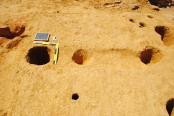CAMPAGNA 2018 |
1° SETTIMANA |
2° SETTIMANA |
3° SETTIMANA |
4° SETTIMANA |
5° SETTIMANA |
6° SETTIMANA |
7° SETTIMANA |
8° SETTIMANA |
9° SETTIMANA |
18 LUGLIO 2018 
Resoconto della giornata di scavo
Area 3000
Nella porzione meridionale si è proceduto con l’abbassamento generale del settore e con la rimozione dello strato a matrice argillosa US 3935. Nella porzione settentrionale è stata completata l’indagine delle buche UUSS - 3956 e – 3958, di forma circolare e con un diametro di circa 30 cm, poste in linea con US – 3943, con orientamento W-E.
Today in the Northern Section the excavation of the hole -3958 was finished to the level of 60cm. In cut-3961 at the bottom of the old fur 2cm were dug out and the bottom of the cut was found, since there was no obvious osteological remains the cut was considered finished. In the Southern section of today we will pick up the level with the western facade, then we will clean the area.
Area 5000
Lo scavo del settore C ha messo in luce alcune interessanti evidenze stratigrafiche. Nello specificio si tratta di alcuni riempimenti di tagli dalle forme e dimensioni molto diversi tra di loro. Il primo di questi, US 5594, costituisce il fondo di un taglio già individuato nel 2015. US 5596 invece è un riempimento a matrice molto scura individuato all'interno di un taglio ellittico di 20 cm x 10 cm circa. La buca sembra disconnessa da qualsiasi altra attività individuata in queste fasi e al suo interno non sono stati trovati frammenti ceramici in grado di datare l'US. Infine, nella regione più occidentale, direttamente a nord rispetto alla fornace per la fusione della campana è stata individuata una buca quadrangolare riempita con del sedimento nero carbonioso in cui sono stati trovati frammenti di carbone, ceramica e frammenti litici tra cui una scheggia di selce lavorata. E' molto probabile che il taglio fosse stato creato in origine per una migliore ossigenazione del condotto di areazione della fornace.
We continued exposing more of the features. Two members of our team continued to open up the possible structure on the East side of area C and level down the surface. A bone was exposed under the 12th century wall during this process. Meanwhile, another member of our teame worked on further exposig and finding the edge of the charcoal deposit. We discovered that this deposit extends far further than previously imagined and the feature has now approximately doubled in size. During the excavation process, a szeable piece of Roman pottery was dislodged along with a large quantity of brick and two pieces of flint - one of which was retouched. We are not sure if the feature extends further or there is evidence that there is another feature cut next to this one. We moved beyond section C to the recently opened section D (to the East of C), the"mysterious pit". One member of the team proceeded to level down the mid-section between two previously dug pits, where scattered bones had been found. During this process, a couple of fragmented pieces of friable bone were recovered (one possible fragmented proximal phalanx of the hand).
Area 6000
Prosegue la messa in luce dell’individuo USk 6236 al centro del settore sud, mentre USk 6220, sul lato occidentale, è stato definitivamente rimosso e catalogato per essere analizzato in laboratorio. Sulla porzione orientale del settore si sta scavando lo strato US 6217, a ridosso della facciata e di USM 3047. Tale strato fa riferimento ad un’azione di livellamento dell’area durante le molte fasi cimiteriali che si sono succedute tra il XII ed il XIII secolo, ciò spiega la forte presenza di ossa sparse nella matrice dello strato.
Today in area 6000 we continued removing fill 6217 to level the area and may have exposed part of a burial. There seems to be an elbow in loose articulation and then higher up possibly a scapula. In the Eastern part of the 6217 fill we discovered very fragmented pieces of bone that are so far unidentifiable. A nail was discovered within this fill.
We continued extracting fill 6235 to uncover the remains of the burial. We worked to uncover more of the upper skeletal remains further revealing the vertebrae as well as removing more of the fill from the outer rim of the burial. We are still unsure if we will find the cranium within this burial as we previously discovered a potential separate fill, however more excavation needs to take place in order to determine if this is correct.










